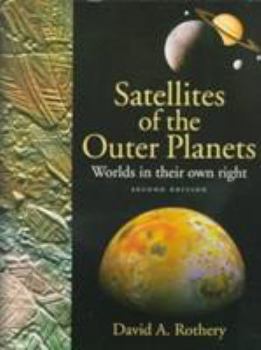Satellites of the Outer Planets: Worlds in Their Own Right
Select Format
Select Condition 
Book Overview
Extensively revised and updated, this new edition of David A. Rothery's acclaimed geological guide to the outer solar system includes results and close-up color and black and white images from both the 1995-1999 Galileo mission to Jupiter and the Voyager space probe. Rothery, a noted planetary
scientist, explains the geological aspects of the major satellites of the outer planets, from Jupiter to Neptune and the Pluto-Charon system. In particular...
Format:Paperback
Language:English
ISBN:019512555X
ISBN13:9780195125559
Release Date:December 1999
Publisher:Oxford University Press, USA
Length:264 Pages
Weight:1.55 lbs.
Dimensions:0.5" x 7.5" x 10.0"
Customer Reviews
3 ratings
the best scientifically accurate but still very accesible review of the outer solar system
Published by Thriftbooks.com User , 15 years ago
author does a great job of giving the relevant information while still being accessible to someone out side this field. I happen to be in this field and this book was used as a supplement in a course about the icy satellites of the outer solar system. thus it comes well recommended by a professor in the field. I found a lot of relevant information and the significance of all the fact is explained in terms of why we should care and thus is quite an interesting book :)
Not for the casual reader!
Published by Thriftbooks.com User , 19 years ago
This book is not really for the casual reader. On the contrary; this book is rather technical. The first four chapters deal with geological subjects like planet formation, satellite formation, accretional heating, radiogenic heating, tidal heating, partial melting, icy volcanism etc. etc. etc., and describes the Voyager and Galileo space probes. Then follows a description of (only) the bigger satellites. In describing the "world in their own right", the writer puts them into the following categories: DEAD WORLD: Callisto (11 pages), Rhea, Iapetus, Mimas, Oberon and Umbriël (all 2-3 pages each). RECENTLY ACTIVE WORLDS: Ganymede (13½ pages), Miranda (8½ pages), Ariël (8½ pages), Dione (6 pages), Tethys (4½ pages), Titania 1½ pages). ACTIVE WORLDS : Io (18½ pages), Europa (17½ pages), Triton (12 pages) and Enceladus (6 pages). UNSEEN WORLDS : Titan en Pluto/Charon (3½ pages each). Each moon is visualised with photograps (circa 95 photographs in total, of which nine in color), "shaded relief maps" (a total of 16) and plenty diagrams/drawings etc. If the emphasis on geology in this book does not appeal to you, I advise you to leave the book alone. If, for instance, you only want really impressive photographs then buy a book like "Beyond: Visions Of The Interplanetary Probes". That book has much nicer photographs. If on the other hand you really want to dig into the subject of how these "world in their own right" came to be and if you want to understand what you see on photographs of these moons, then this is your book! The writing style is clear and understandable. You don't have to be a geologist already. This book will offer you many hours of enjoyable reading!
Geological Processes that Shaped the Outer Planet's Moons
Published by Thriftbooks.com User , 23 years ago
Though the number of pages in this book may seem a bit small to provide a good explanation the geological processes that shaped and are still shaping the moons of the outer planets, the author does an excellent job of doing just that. Excluding the Moon and the two small satellites of Mars, this book covers all the planetary satellites (moons) of our solar system. The book does include the latest findings (as of 1999) from the Galileo space probe.The first quarter of the book describes in quite some detail, at least for the non-geologist, the different theories that have been used to classify these planetary bodies. The remainder of the book, excluding the conclusion section, is divided into three parts: dead worlds, recently active worlds and active worlds. Each of the moons falls into one of these categories and a detailed description of each moon is provided in its corresponding section. Each section also includes high resolution Voyager and Galileo photographs and shade relief maps. After finishing this book, I came away with the idea the solar system is a very geologically diverse place and there is a lot we don't know. Even the author, in several places was willing to admit to that.





